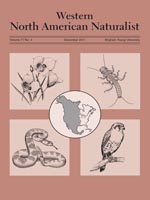Size-structured spatial patterns in larvae of 2 sucker and 3 minnow species are described from fixed-site sampling in Upper Klamath Lake, Oregon, and are used to demonstrate patterns of size-based losses downstream and retention in the lake. The smallest larvae of shortnose suckers (Chasmistes brevirostris), Lost River suckers (Deltistes luxatus), and tui chubs (Siphateles bicolor) were least likely to be found in Lake Ewauna, a downstream catchment; yet the proportion of larger larvae downstream was often substantial, 20%–40% of a size class. In contrast, the smallest larvae of blue chubs (Klamathella coerulea) and fathead minnows (Pimephales promelas) were least likely to be found in restoration marshes. For these 2 species, interannual differences in spatial size-structuring was variable, with larger size classes being found in high proportions in restoration marshes in some years but not in others. These patterns may be indicative of substantial emigration from Upper Klamath Lake, in the case of suckers and tui chubs, and of variable use of restoration marshes by larger blue chubs and fathead minnows. Although this and other approaches can provide insight into larval emigration and movement, spatially intensive sampling and knowledge of circulation patterns may allow for more rigorous estimates of larval movements.
How to translate text using browser tools
1 December 2011
Size-Structured Spatial Patterns as a Measure of Larval Dispersal and Emigration
Douglas F. Markle
ACCESS THE FULL ARTICLE





